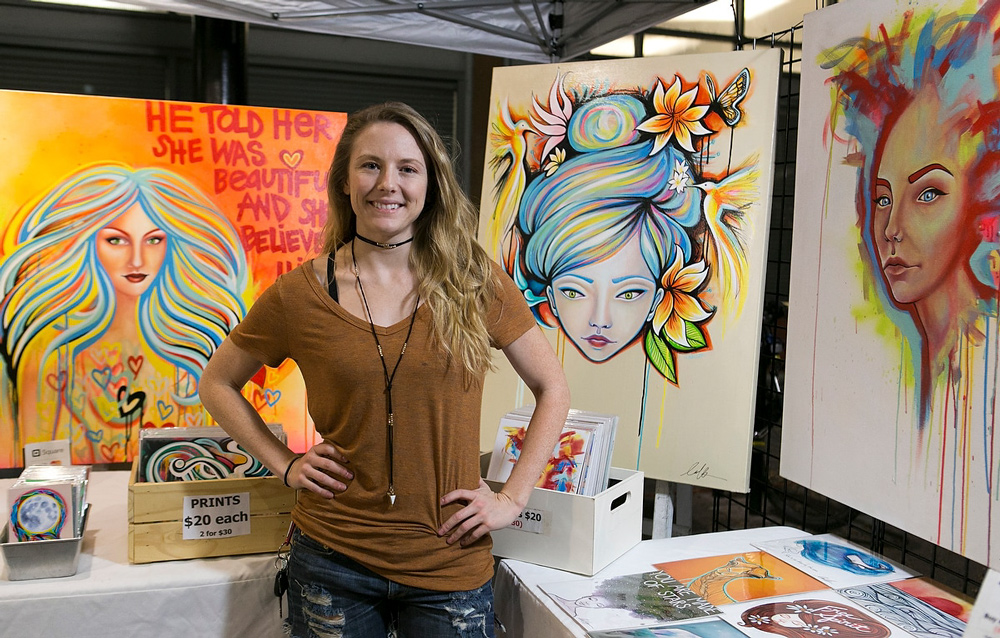Want to Become an Arts Vendor? Here's Where to Start
If you are an artist or if you enjoy being crafty as a hobby or even as your career, becoming an arts vendor is a great way to spread the word about your creations.
Becoming an arts vendor at local festivals, street fairs, and shows can significantly increase the interest you receive in your pieces and the number of sales you make. Before you get started with your next show as a vendor, there are a few factors to consider and keep in mind.

1. Location, Location, Location
Consider the location(s) you are interested in attending as an arts vendor, especially if you are new to being a vendor at an arts and craft show or event. Research and compare upcoming art shows, dates, and locations. Once you are familiar with the locations of various shows, you can determine which shows are suitable for you and what you will need to travel to these events on your own; if you are willing to,
that is.
2. Licensing and Permits
Sometimes, you may require a special license or permit selling your art or to even display it, depending on the type of show you are attending, as well as any requirements or regulations that may already be in place. Many art-centric events require an Arts Entertainment License in order to allow the display and/or selling of pieces, even when working with individual vendors.
You may also require a permit depending on the location you are hosting your event and whether it is indoors or being held outside. Other permits to consider depending on the event and location:
- Business license (state, city, county)
- Selling permit
- State sales tax license
-
Registration of trade name
3. Brand Identity
Promoting art of any kind is difficult, especially as the arts industry is often highly competitive and saturated, regardless of the type of art you are interested in creating and potentially selling. When you want to be taken seriously as an arts vendor, you need to cultivate an identity for your brand that is relevant, modern, and professional.
Developing your brand’s presence and your brand’s logo and business cards can go a long way when making new connections and making a lasting, positive, professional impression.
Some brand identity factors to keep in mind when you are looking to become an arts vendor include:
-
Logo: You will need a logo to represent the work you create, even if you are creating art as a solo artist. Use a logo that is completely unique and one that uses a set color scheme you have in mind. Consistency is key for creating a successful logo, regardless of the industry you are in.
-
Story/Mission: Having a story, mission, or even a backstory can help with garnering interest in your artwork, especially if you are new to the business. A story can also help to showcase your work in a way that helps others connect to it, providing more meaning to it for some.
-
Website: Creating an online presence is key for any business or individual today. Developing a website is a great way to display your artwork, style, and abilities, as well as any upcoming events or shows you plan to attend.
-
Business Card: Having a business card is essential when you want to be taken seriously, especially when entering the highly competitive world of art.
-
Contact details: Always include contact details on your website, or anywhere you promote your art, to increase your chances of generating leads and potential sales.
4. Obtain Necessary Gear
If you intend to travel to an art show as a vendor, you will also need to determine which gear you will require and get it. Getting traveling gear, displays, and even containers to transport your art should all be considered whenever you are thinking of attending an art show.
5. Estimate Costs
Consider the cost of attending a vendor show and how much it costs you to create your pieces individually or even as an entire set, depending on the type of work you do. Evaluate the cost of labor and any materials used to create your art and the time spent traveling and setting up to determine a price for the piece(s) you intend to sell.
6. Choose Payment Gateways
When you are attending an art showcase or event as a vendor, you will need to choose the payment gateways and methods you accept as a seller. For some art vendor shows, you may be limited to the type of gateways that are available, which is why it is advisable to inquire about your options ahead of time.
Consider whether you will accept cash, Square, Venmo, Cash App, or other alternative sources of payment, based on how you intend to manage your art business.
7. Consistency is Key
For building any business, brand, or reputation, consistency is key. Being consistent in your creations, updates, and even with your communications to loyal followers, fans, and customers can go a long way while breaking into the art world, especially when doing so for the first time.
8. Collaboration Efforts
Working together with other vendors is another way to boost your visibility, both online and off. When attending a local art show or vending event, network with other vendors to make connections that may come in handy in the future.
9. Marketing Online and Off
While it is possible to sell your art at a local art show, you should never limit yourself. Selling and displaying your artwork online and using many platforms simultaneously to showcase and sell art is a way to significantly increase your chances of making a sale. You can also use multiple online and local platforms to promote upcoming sales and inventory to generate interest in the creations you will soon have available.
Displaying, showcasing, and selling your art as a vendor is one of the fastest ways to build a brand and reputation, especially if you are interested in making local connections. As an arts vendor, learn how to boost sales, connect with relevant business owners, and share your work among your entire community.






